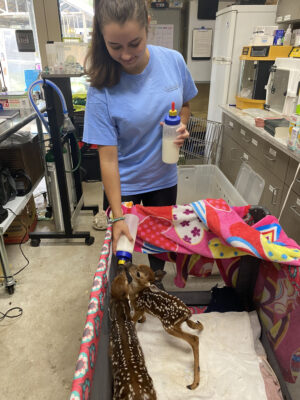
I was so wrapped up with Lake the otter last week I didn’t have the energy or enthusiasm to write much about the wonderful place that fostered him, the Ark Wildlife Care and Sanctuary out in Hilliard. Jonathan Howard and his volunteers sure have their hands full with more than just a handicapped baby otter.
When I went out there the first time last week (see last week’s column) a lot was going on. The main workroom/vet clinic where Lake was housed also had a pen with three very young fawns and another enclosure with three baby silver foxes. Jonathan was fielding calls from another person with another abandoned fawn. Jonathan carefully interviewed her about where it was, how long it had been there, and other questions to determine if it indeed was abandoned. He agreed it needed help and told her to bring it on in. Meanwhile, a young volunteer, Katelin Franklin, came into the room to give bottles of milk to the fawns already there. Eventually, she took my friend Betty and me on a tour of the facility while Jonathan attended to other business. I thought three baby fawns were really something until I saw that they had at least another 25 of them of various young ages housed in pens around the facility. All needed to be fed and cleaned daily until they were old enough to be safely released into the wild.

The second day I was there, spending hours holding and comforting Lake, more calls came in to Jonathan: another fawn, this time with a severed hoof, was coming in soon. Jonathan was well prepared to fix or even amputate if necessary—he has done these procedures many times before under guidance from his well-qualified veterinarians, but now he was able to do this himself. Apparently, fawns often get caught up in fences and their legs are injured. Who knew?
At one point a young couple showed up with a cage full of baby opossums they had rescued and raised until they discovered this was illegal without a permit. They could apply for a permit, but all this was too much for them and they brought them in to the ARK where Jonathan and his team will take over until they, too, can be safely released. The goal of ARK is to rehabilitate and release these injured and orphaned animals when they are fit to go.
Besides these new babies in their care, the ARK has a variety of animals that, for one reason or another, cannot be released into the wild. Katelin toured us around and showed us the two adult otters, Gangsta and Felony that live in a large well-designed otter enclosure with pools of water, secure den boxes and plenty of land area to romp in. Both have medical issues and are also imprinted on people, making them un-releasable. Nearby a pair of silver foxes have their own enclosure. Jonathan offered to help another facility find a home for their own imprinted fox, and with assurances that she was spayed, they carefully introduced her to their single male. Well, guess what? She wasn’t spayed, thus the three silver fox pups being hand-raised in the clinic.

And there is even more. ARK has enclosures with other foxes and all have dug tunnels into the ground like they would in the wild, thus making their own housing arrangements. Another enclosure holds a group of raccoons, imprinted too, including the fattest raccoon I’ve ever seen. A nutria in another cage came rushing to the fence to greet us with a chirruping sound, showing off its orange teeth. Two other enclosures held un-releasable bobcats. Squirrels, bats, opossums, armadillos, and most other native Florida mammals are also housed here. Some of these animals were raised here, but many were confiscated by the Florida Fish and Wildlife Conservation Commission from private owners without permits to keep them and ARK provides a forever home for them where they are well cared for.

I knew of the ARK before this visit, but now that I know even more about them, I am an eager supporter of their work. And you can be too if you visit their website. I want to thank those of you who read my column last week and donated to them already. Jonathan and his team thank you!
Pat Foster-Turley, Ph.D., is a zoologist on Amelia Island. She welcomes your nature questions and observations. [email protected]

Another FANTASTIC article Ms. Pat! ARK is AMAZING!!
Great article (I always enjoy Dr. Foster-Turley’s articles) and great organization. I’m curious … I have been told that armadillos are not actually considered a “Florida native”. A local trapper told me he could relocate other species but armadillos had to be put down.